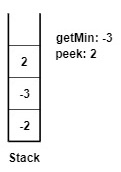Design Min Stack Data Structure | Stack Problem
4 years ago Lalit Bhagtani 0
Problem Statement
Design a stack data structure that supports the following operations in constant time O(1).
- push(N) :- It insert element N onto the top of the stack.
- pop() :- It removes and returns the element from the top of the stack.
- peek() :- It returns (not remove) the element from the top of the stack.
- getMin() :- It returns the minimum element in the stack.
Example

MinStack stack = new MinStack();
stack.push(-2);
stack.push(2);
stack.push(-3);
stack.getMin(); -- value: -3
stack.pop();
stack.peek(); -- value: 2
stack.getMin(); -- value: -2
Solution
The Linked List data structure can be used to design Min Stack data structure. Each node of linked list will contain three parts :
- Data Part:- It contains the value to be pushed into the stack.
- Min Part:- It contains the minimum value among all values, currently stored in the stack.
- Next Part:- It contains pointer the next value in the stack.
Each operation of the min stack will work in the following way:
- push(N) :- It creates and inserts a new node to the head of the linked list. Node’s data part contains element N, next part contains the current head of the linked list and min part contains a value, which is a minimum of element N and data part of the current head of the linked list.
- pop() :- It removes and returns the head node and makes node next to the head node as a new head of the linked list.
- peek() :- It returns data part of the head node.
- getMin() :- It returns min part of the head node.
Program
public class MinStack {
public static void main(String[] args) {
MinStack stack = new MinStack();
stack.push(-2);
stack.push(2);
stack.push(-3);
System.out.println("Min: " + stack.getMin());
stack.pop();
System.out.println("Peek: " + stack.peek());
System.out.println("Min: " + stack.getMin());
}
private class Node {
int val;
int min;
Node next;
Node(int val, int min){
this.val = val;
this.min = min;
}
}
private Node stack = null;
public void push(int x) {
Node node = new Node(x, x);
if(this.stack == null){
this.stack = node;
}else {
if(this.stack.min < node.min){
node.min = this.stack.min;
}
node.next = this.stack;
this.stack = node;
}
}
public void pop() {
if(this.stack != null){
this.stack = this.stack.next;
}
}
public int peek() {
if(this.stack != null){
return this.stack.val;
}
return -1;
}
public int getMin() {
if(this.stack != null){
return this.stack.min;
}
return -1;
}
}
Result
Min: -3
Peek: 2
Min: -2
Similar Post
- Design Max Stack Data Structure
- Design Maximum Frequency Stack Data Structure
- Remove All Adjacent Duplicates In String
That’s all for Design Min Stack Data Structure in Java, If you liked it, please share your thoughts in a comments section and share it with others too.
